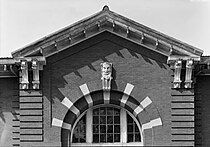St. Elizabeth’s Hospital
|
St. Elizabeths Hospital
|
|

The Center Building at St. Elizabeths in 2006
|
|
| Location | 2700 and 2701 Martin Luther King, Jr., Avenue, 1100 Alabama Avenue SE Washington, D.C. |
|---|---|
| Coordinates | 38°51′03″N 76°59′40″W / 38.85083°N 76.99444°WCoordinates: 38°51′03″N 76°59′40″W / 38.85083°N 76.99444°W |
| Area | 346 acres (140 ha) |
| Built | 1852 |
| Architect | Thomas U. Walter; Shepley, Rutan and Coolidge |
| Architectural style | Italianate Revival, Italian Gothic Revival |
| NRHP reference # | 79003101 |
| Significant dates | |
| Added to NRHP | April 26, 1979 |
| Designated NHL | December 14, 1990 |
 |
|
|
|
St. Elizabeths Hospital opened in 1855 as the first federally operated psychiatric hospital in the United States. Housing over 8,000 patients at its peak in the 1950s, the hospital at one point had a fully functioning medical-surgical unit, a school of nursing, and accredited internships and psychiatric residencies. Its campus was designated a National Historic Landmark in 1990.
St. Elizabeths is in southeast Washington, D.C.. Since 2010, hospital functions have been limited to a portion of the east campus operated by the District of Columbia Department of Mental Health. The remainder of the east campus is slated for redevelopment by the District of Columbia which owns the site. The west campus is owned by the federal government and is being redeveloped for use as headquarters for the U.S. Department of Homeland Security and its child agencies.
The hospital was created in August 1852 when the United States Congress appropriated $100,000 for the construction of a mental hospital in Washington, D.C.; to provide care for indigent, mentally ill residents of the District of Columbia, as well as for the insane of the U.S. Army and U.S. Navy. As early as the 1830s, local residents including Dr. Thomas Miller, a local doctor and president of the D.C. Board of Health, had been petitioning Congress for a facility to care for the mentally ill in the City of Washington. Their efforts were given a significant boost when Dorothea Dix (1802-1877), a pioneering advocate for people living with mental illnesses, helped convince legislators of the need for the hospital. In 1852 she wrote the legislation that established the hospital. Dix, who was on friendly terms with President Millard Fillmore, was asked to assist the Secretary of the Interior in getting the hospital started. Her first recommendation resulted in the appointment of Dr. Charles H. Nichols as the hospital's first superintendent. After his appointment in the fall of 1852, Nichols and Dix began formulating a plan for the design and operation of the hospital as well as finding an appropriate location for it, based upon guidelines created by Thomas Story Kirkbride. His 1854 manual recommended specifics such as site, ventilation, number of patients and the need for a rural location proximate to a city. He also recommended that the location have good soil for farming and gardens for the patients.
...
Wikipedia



